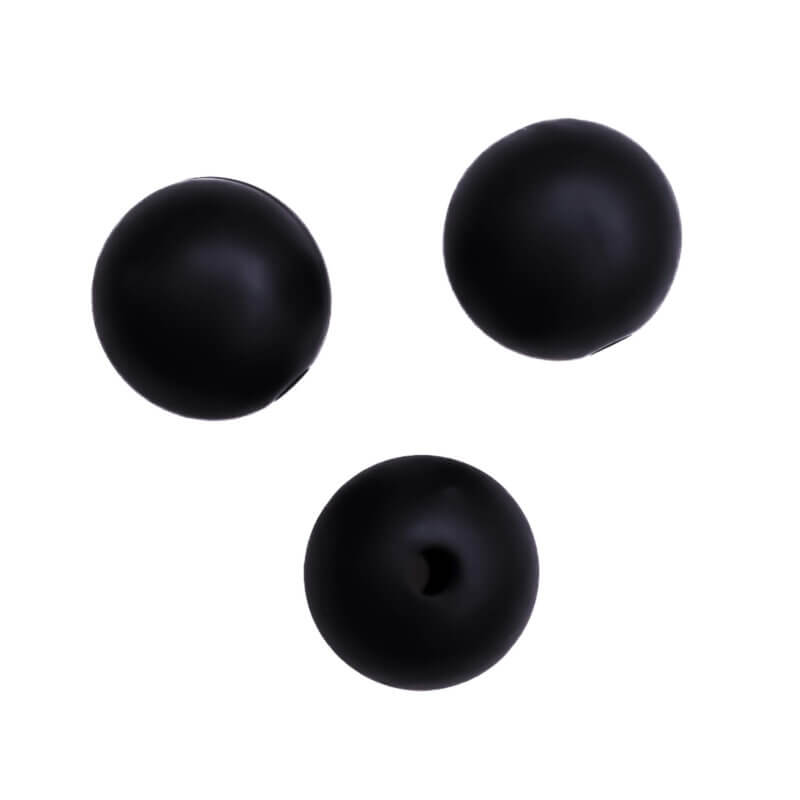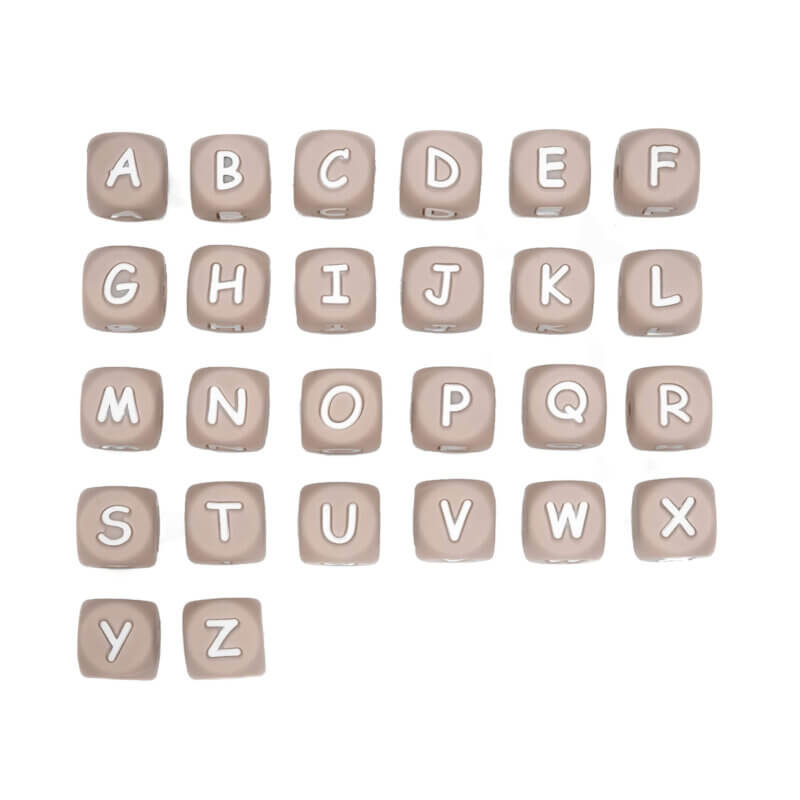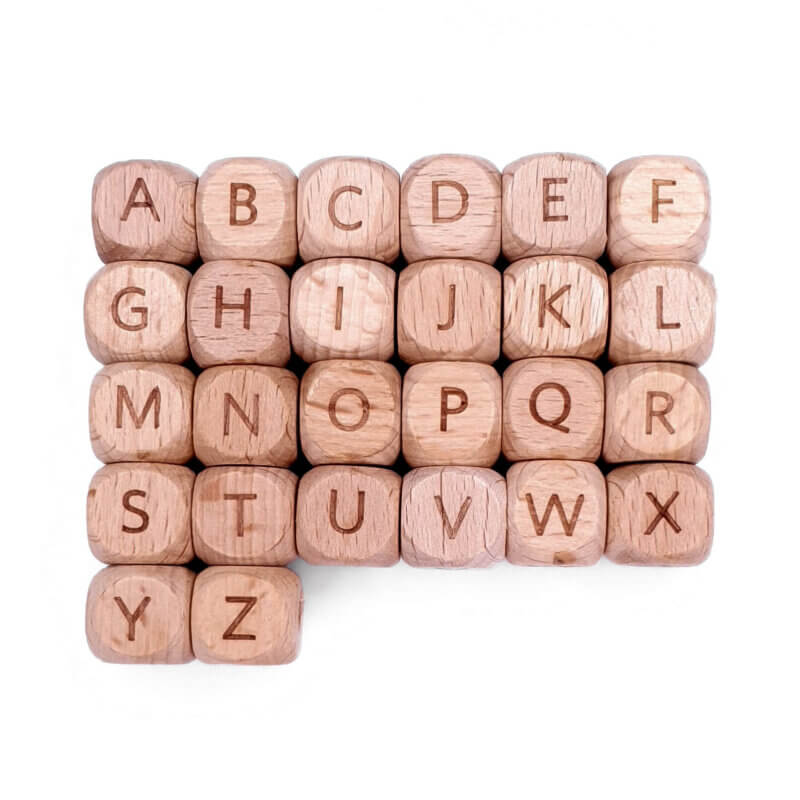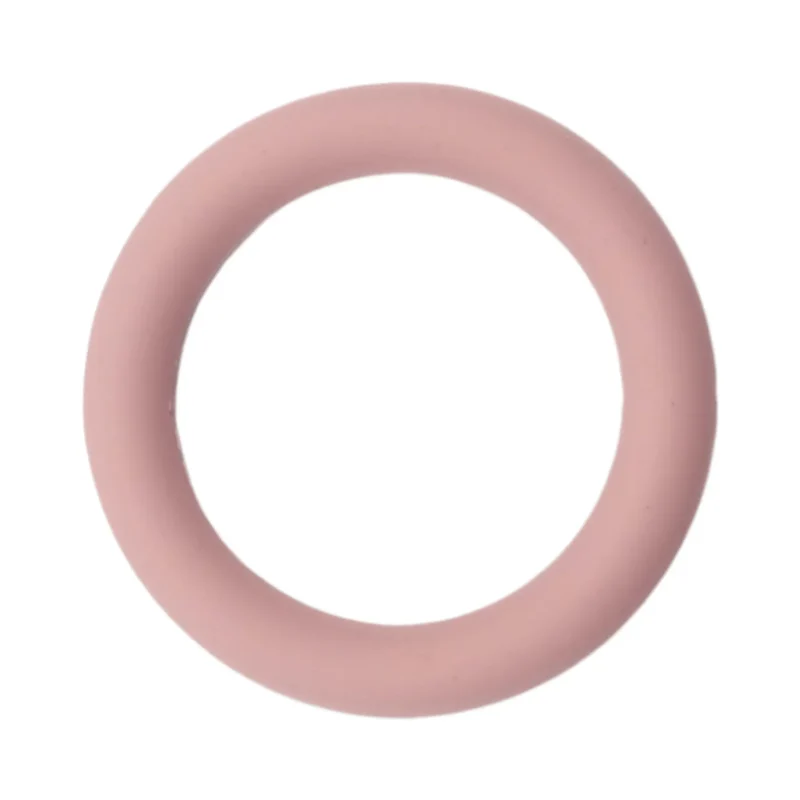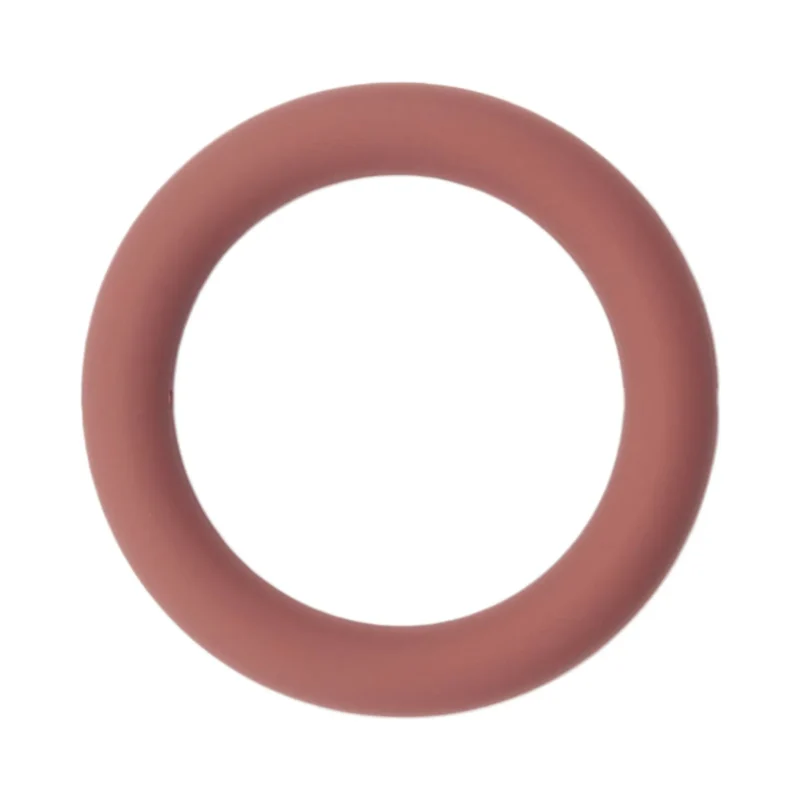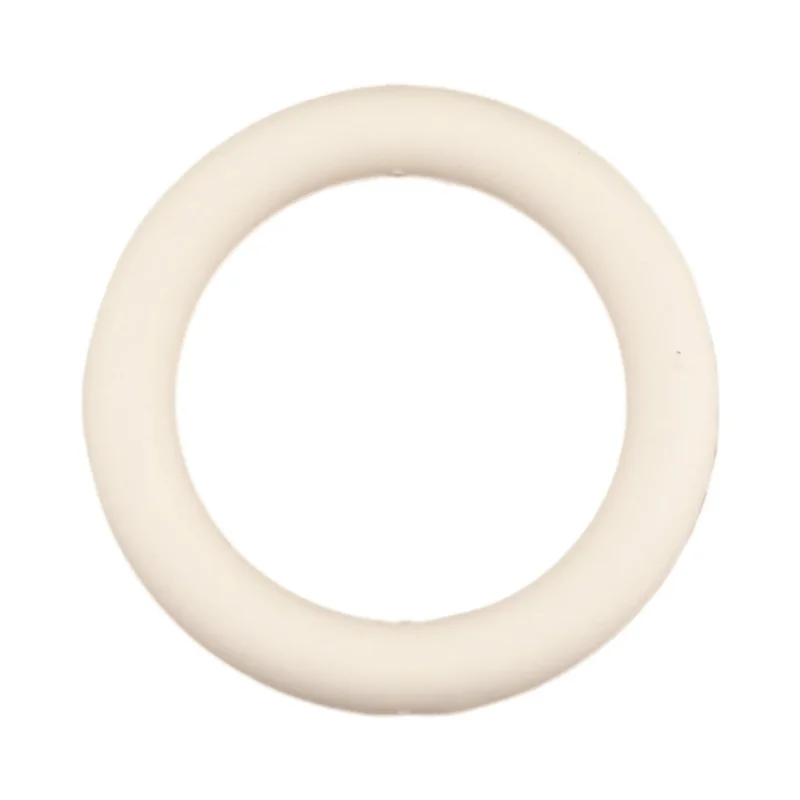Making teething ring – DIY tutorial
Making teething ring – DIY tutorial

Amber Winsveen
Jootjes Crochet Gifts
Printable version in PDF available here:
Teething Ring Making – DIY Manual
Introduction
At Jootjes Crochet Gifts you have come to the right place to make your own baby teething toys. The tutorial below will give you the necessary instructions for making your own teething ring. The tutorial is of a very simple teething ring but of course you can vary this in many ways. As a wholesaler of baby teething toy materials, we also supply you with all the supplies you need to make this teething ring through our web shop. All our materials are completely baby safe, 100% free of toxic substances fully compliant with European Directives. We have therefore been the market leader in baby teething toy materials for a long time. Look around our webshop or blog or follow us on Facebook, Instagram or Pinterest for lots more inspiration. You will find many examples of teething rings, inspiration regarding other types of baby teething toys and color combinations.
Supplies:
- Silicone or beech wood beads fully assembled as desired. See below for more information.
- Satin cord Of at least 1.5 mm thickness. We recommend 2 mm. Length 1 meter.
- 1 or 2 beechwood or silicone rings/figures
- 1 Slim blunt
basting needle
- Combination pliers.
How many beads are needed to make a teething ring?
There is not just one way to make a teething ring. By the time you read this guide, you’ve probably seen all kinds of cool teething rings come by. There are so many beautiful creations out there. That’s perfect for inspiration.
Don’t yet have a good idea of what you would like to make or would like a guideline to start from. On average, we apply the following:
- 10 beads of 20 mm or approximately 12 beads of 16 mm. This gives a total length of about 20 cm (all the beads in a row). If you substitute something for a shape or a different size, try to stick to this.
- We don’t usually use 12 mm for a teething ring. With a teething ring, we assume it will be bitten on a lot. Then we prefer a bead with a little more volume.
- In my opinion, a 20 mm bead gives the most beautiful effect but is a bit heavier to use. If you give a teething ring as a maternity gift to a newborn, we recommend the 16 mm beads (because the teething ring remains lighter). For little ones with teething, the 20 mm beads are perfect for a teething ring.
All of the above materials are available on our webshop!
Step 1: Stringing a teething ring
Take the 1-meter piece of satin cord. Put one end through the eye of the blunt needle and thread the chosen beads onto the thread in the desired order. Then thread pendants or rings over the beads as desired. Remove the needle from the satin cord.
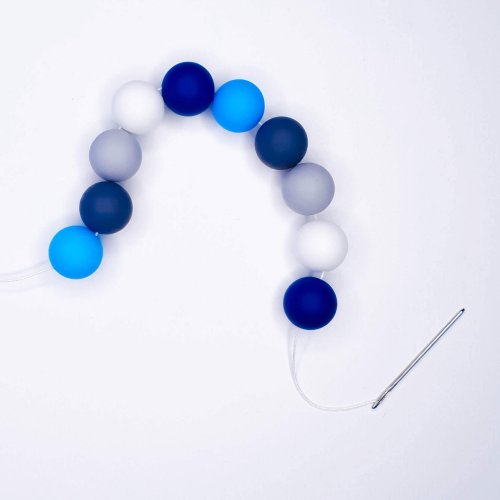
Step 2: Tying the teething ring
Additional note: At this step, the advantage of the 1-meter length of satin cord comes into play. We often get the question; “I always have a piece left over, can’t it be shorter?” To make a teething ring, you want to be able to tie knots multiple times to ensure good strength. You simply need a good length to be able to tighten the knots laid with sufficient force. Don’t be afraid to tighten the buttons, either. Use all the power you have. Satin cord doesn’t break when making it, which is exactly why we use it! Take advantage of this. If the ends are too short you can’t tie good knots. A piece of overlength is therefore a necessity.
Tying the teething ring itself:
1. Take the two ends of the satin cord and tie a double flat knot (left end over right end). For a double flat knot, you flip 2 times. This creates an extra wrap that ultimately provides extra grip for the knot. Pull well firmly. The strand of beads now forms a ring. Pull this ring firmly closed and tighten the knot firmly.
2. The knot is not yet finished. Similarly, tie a second knot on top of the first knot. In doing so, you wrap with the right end over the left. Therefore, the windings run against each other in terms of direction, giving them extra grip. This method of knotting is also called surgical knotting because it is used by doctors*.
*Originally, in fact, I didn’t start in the teething business at all. I am a graduate and working as a physician. So for the creation of Jootjes Haakcade presents, I do often jokingly say from stitching to crocheting and making. Therefore, my background is very fine for me in assessing the baby safety of the materials offered.
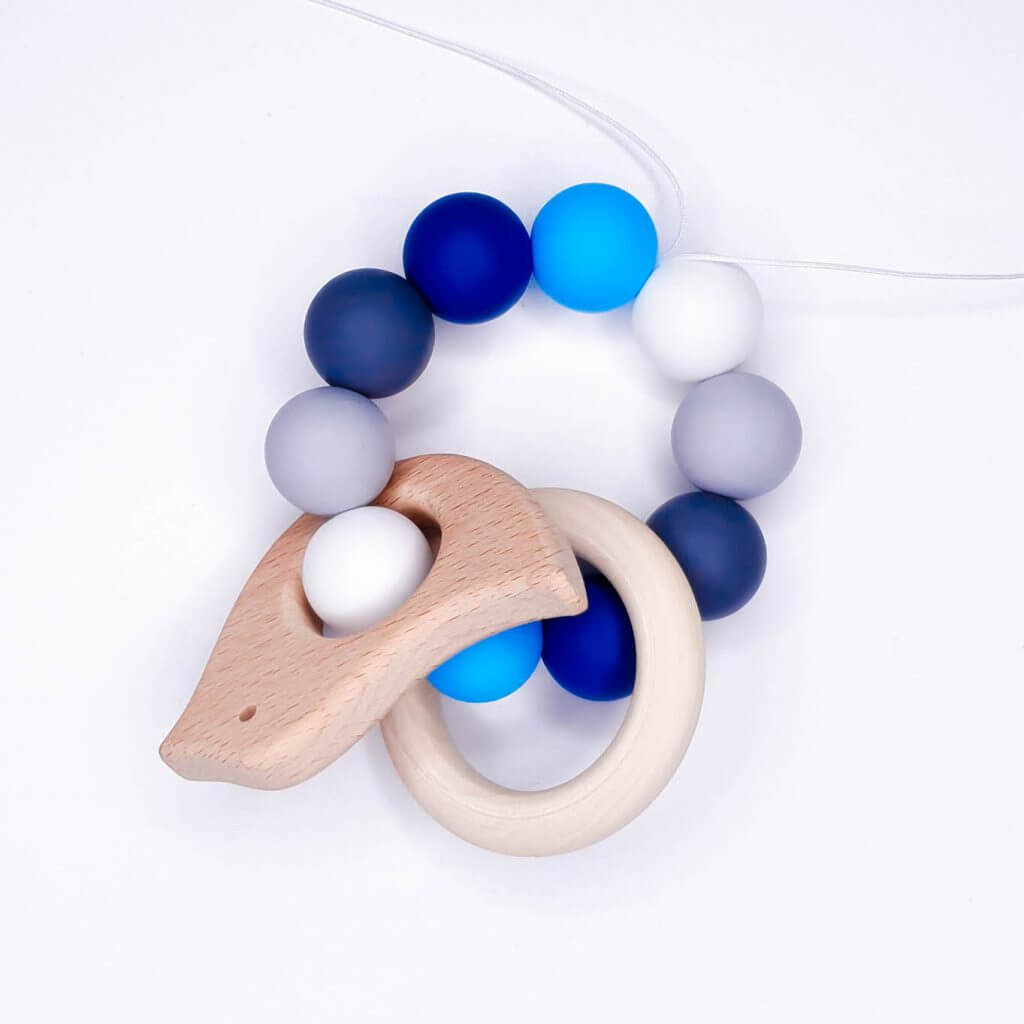
Step 3: Securing the teething ring
You got a nice round ring after the first tying (step 2). On one side of this ring is now a knot with the two ends of satin cord. Take 1 of these ends and thread it back onto the basting needle. You’re going to thread this end back. You do this by poking into the hole of the adjacent bead, to the left or right of the knot. As it were, you continue the way back that the cord has already walked on the first lap. After tucking the first bead back, pull the knot you made aside into the bead so that it is no longer visible. Continue to thread back until you reach the exact opposite side of the teething ring; right across from the knot. The teething ring from our example has 10 beads of 20 mm. So after putting back 5 beads, you are halfway there.
Threading back can sometimes be a little heavier because there is already a cord in the beads. This is why we always use combination pliers when making a teething ring. With this we grasp the needle and pull the needle through. This gives much more grip and control over the needle and helps with power. Using combination pliers will eventually cause wear on the needle. But we always say good tools should be used well and safety and good construction of a teething ring is number one. Therefore, at Jootjes Haakcadeautjes we have very sturdy but also very affordable basting needles should you ever need to replace your basting needle.
Then thread the other end also through the beads back in the other direction. If you went left with the first end, now go right until you reach the opposite side of the first knot. This is how the ends come back together on the other side of the teething ring. Again, tie a double knot in the same way as described in step 2.
Step 4: Stitching off the teething ring
You now have a knot on both sides of the teething ring. We find that this makes the teething ring very reliable if you have tightened the knots properly and hard. So now we are going to get rid of the threads.
Put one end on the basting needle. For this part, again, you need the combination pliers. It doesn’t matter what thickness of cord you chose. You have to go through another adjacent corral, which has already been filled by the cord. Thread left or right through the adjacent bead. Does the same with the second end (through the same adjacent bead). After this, pull the last knot into a bead as well. Make sure your previous knot does not show up again. Sometimes then you just have to pull through. Then I thread both ends 1 more bead (you will be a total of 2 beads from the last knot).
The remaining ends now stick out. You can now start cutting away the ends. Cut the ends as close to the bead as possible.
Of course, it is also possible to first tie more fuse knots as you wish, as many times as you wish, and then still stitch off as needed. This, if you ask us, is not necessary for a sturdy teething ring. It can also cause you to end up with a slightly stiffer teething ring or not be able to tie the knots as nicely. Of course, this is also customizable to your own liking. The end goal is for your creation to be baby-safe.
The teething ring is now complete!!! ❤ Have fun with your final creation!
Love,
Team Jootjes
DISCLAIMER:
In this tutorial, the teething ring is made from satin cord, making it very durable. Satin cord is very sturdy because of the way it is produced (weaving/textile processing) and has a lot of grip/friction at the knots. Therefore, these buttons do not come off easily when tightened. However, wear and tear is always possible with any product you use, that’s just a fact.
Jootjes Haakcadeautjes does not produce the teething ring itself and can never be held liable for potential damage caused by loose teething rings. We show a way to make the teething rings that we think is a very reliable way. However, production and use of a teething ring is always at your own responsibility. Jootjes Haakcadeautjes can never be held responsible for damages resulting from the use of one teething ring produced based on these instructions. Anyway, our advice is strict. Always use teething toys only under the supervision of a responsible adult!
COPYRIGHT
: Jootjes Haakcadeautjes, all patterns and manuals of Jootjes Haakcadeautjes may be published exclusively by Jootjes Haakcadeautjes. The patterns and manuals are for personal use and may not be used for commercial purposes. This manual may not be translated or published on your own site, Sharing a link to the manual is of course allowed as long as the source is mentioned and the reference is correct!
Printable version in PDF available here:
Teething Ring Making – DIY Manual
If you have any questions about this blog or our products, send us an email, contact us via Whatsapp, call us or send us a message on social media. You can also click through below to our contact information:








